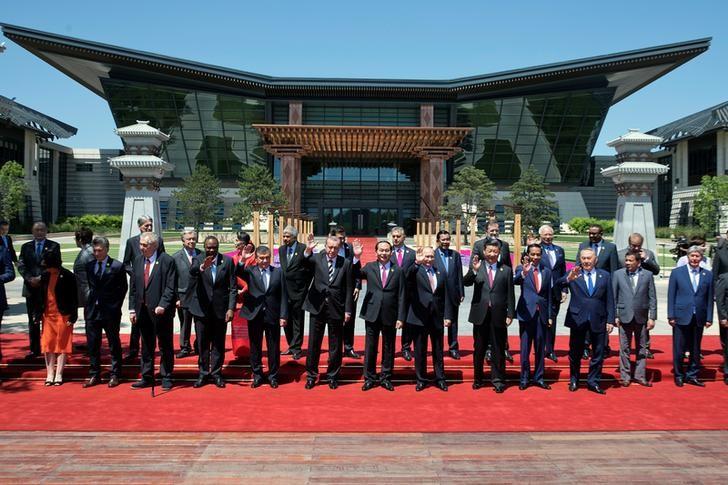
Behind China’s trillion-dollar effort to build a modern Silk Road is a lending programme of unprecedented breadth, one that will help build ports, roads and rail links, but could also leave some banks and many countries with quite a hangover.
At the heart of that splurge are China’s two policy lenders, China Development Bank (CDB) and Export-Import Bank of China (EXIM), which have between them already provided $200 billion in loans throughout Asia, the Middle East and even Africa.
They are due to extend at least $55 billion more, according to announcements made during a lavish two-day Belt and Road summit in Beijing, which ends on Monday.
Thanks to cheaper funding, CDB and EXIM have helped to unblock what Chinese president Xi Jinping on Sunday called a ‘prominent challenge’ to the Silk Road: the funding bottleneck.
But as the Belt and Road project grows, so do the risks to policy banks, commercial lenders and borrowers, all of whom are tangled in projects with questionable business logic, bankers and analysts say.
EXIM, seeking to contain risk, says it has imposed a debt ceiling for each country.
CDB says it has applied strict limits on sovereign borrowers’ credit lines and controls the concentration of loans.
“For some countries, if we give them too many loans, too much debt, then the sustainability of its debt is questionable,” Sun Ping, vice governor of EXIM, told reporters last week.
For now, funds are cheap and plentiful, thanks to Beijing.
Belt and Road infrastructure loans so far have been primarily negotiated government to government, with interest rates below those offered by commercial banks and extended repayment schedules, bankers and analysts said.
Massive government capital injections, bonds priced as sovereign debt and access to the central bank’s pledged supplementary lending programme keep CDB and EXIM funding costs at rock bottom.
In Indonesia, CDB has offered a 40-year concessionary loan, without asking for government debt guarantees, to finance 75 percent of the $5.29 billion Jakarta-Bandung Railway, Indonesia’s first high-speed railway and a model infrastructure project for China’s Belt and Road effort.
The loans carry a 10-year grace period. A 60 percent portion is denominated in U.S. dollars carrying a 2 percent interest rate, and the remaining 40 percent calculated in Chinese yuan, carrying a 3.4 percent rate, according to a note by Bank of China International.
CDB, the world’s biggest development financing institution, says it is not seeking to “maximize profits”, Vice President Ding Xiangqun told reporters last week.
RISKS AND REWARDS
The concessionary financing has allowed China’s big state-owned manufacturers and infrastructure developers to compete aggressively against foreign bidders.
Forty-seven of China’s 102 central-government-owned conglomerates participated in 1,676 Belt and Road projects, according to government statistics.
China Communications Construction Group alone has notched up $40 billion of contracts and built 10,320 kilometres of road, 95 deepwater ports, 10 airports, 152 bridges and 2,080 railways in Belt and Road countries.
China’s central bank governor Zhou Xiaochuan is among those to warn that this reliance on cheap loans raises “risks and problems”, starting with moral hazard and unsustainability.
China has been caught out before; it is owed $65 billion by Venezuela, now torn by crisis.
“The jurisdictions where many of these loans are going are places that would have difficulty getting loans from Western commercial banks – their credit ratings are not very good, or the projects in question often are not commercially viable,” said Jack Yuan, a bank analyst at Fitch Ratings in Shanghai.
“The broader concern is that capital continues to be mis-allocated by Chinese banks.”
China’s state-owned commercial banks are being pushed to support the government initiative. Top lender Industrial and Commercial Bank of China participated in 212 Belt and Road projects, providing $67.4 billion in credit in total, Chairman Yi Huiman said on Monday.
Bank of China plans to offer $100 billion in credit to such projects by year-end.
“Actually, commercial banks are not very motivated,” said a senior banker at a large Chinese commercial lender. “We don’t provide concessionary loans, and we really don’t want those countries to think that all Belt and Road loans are discounted.”
The biggest hangover may yet be for the borrowers.
For Laos, one of Asia’s poorest countries, the $7 billion cost for the China-Laos railway was more than half its 2015 gross domestic product. Its concessionary loan from EXIM was set below 3 percent interest.
In Pakistan, where China has pledged to invest up to $56 billion in rail, road and energy infrastructure, its debt and other repayments on Belt and Road will peak at around $5 billion in 2022, according to the Pakistan government’s chief economist.
Ding, from CDB, said loans to heavily indebted, poor countries were within the limit set by the International Monetary Fund, including interest rates and loan periods.
But borrower nations say there is also little choice as China presses its first international development push.
“It’s almost a no-brainer,” said Sima Kamil, CEO designate of Pakistan’s United Bank.
“It’s very easy to say there will be all of this debt, but if we don’t get this, where are we going to go?”
Source – Reuters


















Good article to be read
Nice post
Thanks for sharing